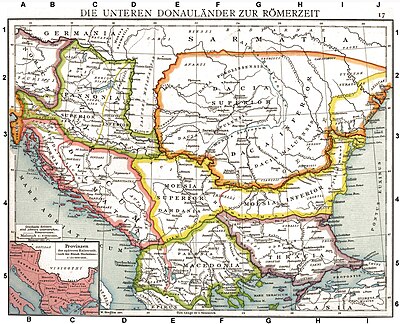
Teurisci was a Dacian tribe at the time of Ptolemy (140 AD). They were originally considered a branch of the Celtic Taurisci (Noricum), who moved to Upper Tisza. However, the archaeology shows that Celts have been absorbed by Dacians, at some point creating a Celto-Dacian cultural horizon in the upper Tisza.
Name
The name Teurisci is considered a variant of Taurisci or Tauristae.
Distribution
Taurisci
Main article: Taurisci
The Celtic Taurisci were settled in the south-eastern Alps and were known from the name of Mount Taurus. Due to iron mining, their centers (i.e. Noreia - now Newmarkt and Virunum now Magdalensburg) enjoyed great success in trade and commerce with the Balkans. The lowland Taurisci gradually grew in power and became largely separate from their mountain relatives. Therefore, the inhabitants of this eastern area became known collectively – from the place name Noreia – as Norici and the territory under their control as Noricum.
Teurisci
Teurisci, attested by Ptolemy in Dacia, were originally a group of the Celtic Taurisci from the Austrian Alps established in North-Western Dacia at the end of Iron Age.
Historical evidence
In 60 BC, when the king of the Dacians Burebista succeeded in uniting his own people with their kindred Getae and Burs into one kingdom he began to put pressure on the Celtic tribes of the Danubian Basin. He advanced against the Taurisci and Boii, gaining his most notable success near to the river Tisza After defeating the Taurisci (Cotini) and Boii, the Dacian King Burebista forced some of them to leave southwestern Slovakia. A Celto-Dacian cultural horizon was created in the conquered territory, Dacian settlement here continued into the second decade of the new era.
Posidonius record that, at his time, Celtic (Boii, Scordisci, and Taurisci) were intermingling with Thracians on both sides of the Danube. Later, Strabo (about 20 AD), repeat this piece of information, yet he uses the variant Ligyrisci instead of the Posidinius's variant Teurisci.
According to Ptolemy (140 AD), Teurisci of Dacia bordered Anarti of Dacia on the east. Further east of them were the Dacian Costoboci.
Archaeological evidence
About 150 BC, Celtic La Tène material disappears from Dacia. This coincides with the ancient writings which mentioned the rise of the Dacian authority. It ended the Celtic domination and it is possible Celts were thrust out of Dacia. Alternatively, some scholars have proposed that the Transylvanian Celts remained but merged into the local culture and thus ceased to be distinctive The Celtic groups which spread as far as Transylvania had been assimilated by the Dacians.
See also
Notes
- Dacia: Landscape, Colonization and Romanization by Ioana A Oltean, ISBN 0-415-41252-8, 2007, page 46
- Thomas H Dyer in Dictionary of Greek and Roman Geography: Iabadius-Zymethus edited by Sir William Smith, Boston, Little Brown and Co. 1857, page 1133
- ^ Dacia: Landscape, Colonization and Romanization by Ioana A Oltean, ISBN 0-415-41252-8, 2007, page 47
- Mannova 1963. sfn error: no target: CITEREFMannova1963 (help)
- Posidonius & Kidd 1999, p. 943.
- Hogain Daithi O. (2007) The Celts: A Chronological History Publisher: Hushion House, ISBN 978-0-85115-923-2 page 61
- Parvan V, Vulpe R, Vulpe A (2002) Dacia Publisher: Editura 100+1 Gramar, page 165 established
- Hogain Daithi O. (2007) ‘’The Celts: A Chronological History’’ Publisher: Hushion House, ISBN 978-0-85115-923-2 page 140-141
- Mannova Elena (1963) Studia historica Slovaca Bratislava : Vydavatel̕stvo Slovenskej Akadémie ISSN 0585-5225
- Posidonius, Kidd I. G. (2004) 945 " and in my time these tribes, and particularly the Bastarnians, were mixed up with the Thracians, rather more to the north of the Danube, but to the south of it as well. And there was Celtic intermingling with the Thracians, too, from the Boii, Scordisci and Taurisci. Some call the Scordisci Scordistae. And the Taurisci Teurisci or Tauristae.
- Otto, Karl-Heinz (2000) Ethnographisch-archäologische Zeitschrift, Humboldt-Universität zu Berlin. Institut für Ur- und Frühgeschichte, Deutscher Verlag der Wissenschaften page 525
- Koch, John T (2005). ‘’Dacians and Celts’’ in Celtic culture: a historical encyclopedia, Volume 1,. ABC-CLIO. ISBN 978-1-85109-440-0., page 549
References
- Koch, John T (2005). ‘’Dacians and Celts’’ in Celtic culture: a historical encyclopedia, Volume 1,. ABC-CLIO. ISBN 978-1-85109-440-0., page 549
- Mannova Elena (1963) Studia historica Slovaca Bratislava : Vydavatel̕stvo Slovenskej Akadémie ISSN 0585-5225
- Oltean, Ioana, (2007) Dacia: Landscape, Colonization and Romanization, Routledge, ISBN 0-415-41252-8
- Posidonius; Kidd, I.G. (1999). Posidonius: The translation of the fragments, Volume 2, Commentary edited by I. G. Kidd. Cambridge University Press. ISBN 978-0-521-62258-5.
External links
| Dacia | |||||||||||||||||
|---|---|---|---|---|---|---|---|---|---|---|---|---|---|---|---|---|---|
| Tribes (List) | |||||||||||||||||
| Kings |
| ||||||||||||||||
| Culture and civilization |
| ||||||||||||||||
| Wars with the Roman Empire |
| ||||||||||||||||
| Roman Dacia / Free Dacians |
| ||||||||||||||||
| Research | |||||||||||||||||
| |||||||||||||||||